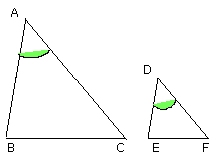If two triangles have one angle equal to one angle and the sides about the equal angles proportional, the triangles will be equiangular and will have those angles equal which the corresponding sides subtend.
 Let ABC, DEF be two triangles having one angle BAC equal to one angle EDF
Let ABC, DEF be two triangles having one angle BAC equal to one angle EDF
 and the sides about the equal angles proportional, so that, as BA is to AC, so
is ED to DF;
and the sides about the equal angles proportional, so that, as BA is to AC, so
is ED to DF;
 I say that the triangle ABC is equiangular with the triangle DEF, and will
have the angle ABC equal to the angle DEF, and the angle ACB to the angle DFE.
I say that the triangle ABC is equiangular with the triangle DEF, and will
have the angle ABC equal to the angle DEF, and the angle ACB to the angle DFE.
 For on the straight line DF, and at the points D, F on it, let there be
constructed the angle FDG equal to either of the angles BAC, EDF, and the
angle DFG equal to the angle ACB;
For on the straight line DF, and at the points D, F on it, let there be
constructed the angle FDG equal to either of the angles BAC, EDF, and the
angle DFG equal to the angle ACB;
 therefore the remaining angle at B is equal to the remaining angle at G.
therefore the remaining angle at B is equal to the remaining angle at G.
 Therefore the triangle ABC is equiangular with the triangle DGF.
Therefore, proportionally, as BA is to AC, so is GD to DF.
Therefore the triangle ABC is equiangular with the triangle DGF.
Therefore, proportionally, as BA is to AC, so is GD to DF.
 But, by hypothesis, as BA is to AC, so also is ED to DF;
But, by hypothesis, as BA is to AC, so also is ED to DF;
 therefore also, as ED is to DF, so is GD to DF.
therefore also, as ED is to DF, so is GD to DF.
 Therefore ED is equal to DG; and DF is common;
Therefore ED is equal to DG; and DF is common;
 therefore the two sides ED, DF are equal to the two sides GD, DF; and the
angle EDF is equal to the angle GDF;
therefore the two sides ED, DF are equal to the two sides GD, DF; and the
angle EDF is equal to the angle GDF;
 therefore the base EF is equal to the base GF, and the triangle DEF is equal
to the triangle DGF,
therefore the base EF is equal to the base GF, and the triangle DEF is equal
to the triangle DGF,
 and the remaining angles will be equal to the remaining angles, namely those
which the equal sides subtend.
and the remaining angles will be equal to the remaining angles, namely those
which the equal sides subtend.
 Therefore the angle DFG is equal to the angle DFE, and the angle DGF to the
angle DEF.
But the angle DFG is equal to the angle ACB; therefore the angle ACB is also
equal to the angle DFE.
Therefore the angle DFG is equal to the angle DFE, and the angle DGF to the
angle DEF.
But the angle DFG is equal to the angle ACB; therefore the angle ACB is also
equal to the angle DFE.
 And, by hypothesis, the angle BAC is also equal to the angle EDF; therefore
the remaining angle at B is also equal to the remaining angle at E;
therefore the triangle ABC is equiangular with the triangle DEF.
And, by hypothesis, the angle BAC is also equal to the angle EDF; therefore
the remaining angle at B is also equal to the remaining angle at E;
therefore the triangle ABC is equiangular with the triangle DEF.
Therefore etc.
Q.E.D